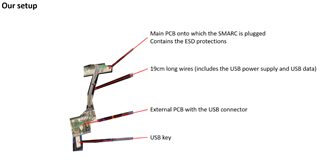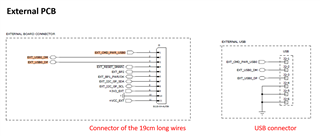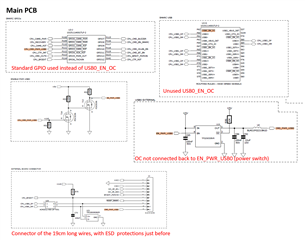Other Parts Discussed in Thread: TPS2052B, TPS2065,
Tool/software:
Hello,
I'm contacting you about a problem we're experiencing with our new design (using a SMARC card): at random, the USB keys we connect to it overheat until they're destroyed (it's no longer possible to recover them afterwards).
It's worth noting that the CPU doesn't seem to be damaged by a destroyed key: when a new key is connected, it works without a hitch.
I'm wondering about the USB power switch. It's the TPS2065DBVR:
It limits the current to 1.5A. However, SMARC recommends using a TPS2052B, which limits current to 0.5A.
On SMARC recommendations, the USB0_OC output is looped back to the USB0_EN_OC input (called EN_PWR_USB0 on our schematic). This is not the case on our board.
We don't have exactly the same ESD protection as on the recommendations.
Concerning ESD: the USB is located on a small external board, connected to the main PCB (which contains the SMARC) via wires about 19 cm long. The ESD protectors are located on the main PCB, about 20 cm from the USB connector.
I've attached a photo of the setup showing the two PCBs and the position of the USB, as well as schematics of our two boards and the SMARC recommendations.
Can you think of a reason for the destruction of the USB flash drives? Do you have any recommendations for further development of the PCBs?
Thank you in advance for your help.





